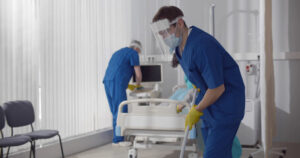Healthcare Facility Cleaning – Why High-Touch Surfaces Are So Important
Healthcare facilities must be clean and sterile. This is due to the high risk of disease and infection.
Specialized cleaning services are needed to help keep medical environments hygienic and free of harmful bacteria, viruses, hazardous chemicals, and waste. Hospital cleaners or janitors require special bloodborne pathogen training that housekeepers do not receive. Quality Cleaning ensures they follow strict industry regulations.
 High-Touch Surfaces
High-Touch Surfaces
Viruses, bacteria, and other pathogens can linger on frequently touched surfaces like doorknobs, light switches, elevator buttons, handrails, etc. Cleaning these areas regularly helps kill germs and prevent them from spreading to employees, patients, or visitors. While it is important to clean all surfaces regularly, it is especially important to focus on high-touch surfaces in healthcare facilities.
These commonly touched objects are typically near sick people who are more susceptible to infection. Germs that cause illnesses such as the common cold, flu, and methicillin-resistant Staphylococcus aureus (MRSA) live on many of these surfaces and can easily be transferred from one person to another. In addition to being a threat to patient health, these pathogens can also lead to hospital-acquired infections (HAIs).
HAIs are associated with severe morbidity and increased costs for both hospitals and patients. Many of these infections are caused by microbial pathogens that are transmitted by the hands of HCWs. The use of improper gloves, poor washing methods, and unclean environmental surfaces are among the leading causes of microbial transmission in hospitals. Fortunately, improved cleaning and disinfection procedures have been shown to reduce the rate of HAIs.
Research has shown that the frequency of wipe cleaning on environmental surfaces is a key factor in reducing HAIs. Surfaces that are touched frequently by patients and HCWs, such as door knobs, bed rails, and light switches, should be wiped more frequently than less-touched surfaces. Moreover, HCWs should wipe their hands after touching high-touch and low-touch surfaces before entering the patient room.
Using the right kind of disinfectant is another important factor in reducing contamination and preventing HAIs. A CDC-approved disinfectant should be used on surfaces that come into contact with patients including hand towels. This will ensure that the disinfectant is effective in killing pathogens.
The best practices approach for cleaning and disinfecting healthcare facilities involves terminal cleaning of public and shared spaces, followed by terminal cleaning within a specified patient zone. This should be followed by targeted cleaning and disinfection of high-touch surfaces inside the patient zone and equipment and tools directly in contact with the susceptible patient.
Clean Before Disinfecting
The surfaces and objects that people touch throughout the day at a healthcare facility are often dirty. That’s because these areas see a high volume of visitors, including patients, doctors, nurses, and other medical professionals. It’s no wonder, then, that the risk of spreading germs is higher in this environment than in a restaurant or retail store.
The good news is that a comprehensive cleaning and disinfection program can significantly reduce these risks. Getting the job done correctly is important, however, as improper cleaning and disinfection procedures can lead to healthcare-associated infections (HAIs) – which can cause serious illness in patients and even death.
Healthcare facilities must follow strict guidelines for environmental cleaning to prevent the spread of HAIs. This includes using the correct commercial cleaning products, janitorial supplies, and specialized equipment. It also involves following a site assessment procedure and employing safe work practices to avoid contamination.
A thorough cleaning should take place before any sanitizing or disinfecting. This is because it removes loose soil, preparing the surface for the application of chemical solutions. Cleaning also lowers the risk of cross-contamination by minimizing the transfer of pathogens from one surface to another.
If a healthcare facility is facing an outbreak of a specific disease, it may be necessary to clean more frequently or implement additional disinfection procedures. This is particularly true if any surfaces in a particular room are visibly contaminated with blood or bodily fluids.
For example, if there’s been an outbreak of Ebola, it might be necessary to clean and disinfect patient rooms and common areas more frequently than usual. It might also be a good idea to consider adding additional cleaning procedures for high-touch surfaces such as door handles, light switches, and shared equipment.
Make A Positive First Impression
When patients arrive at a healthcare facility, they form an impression within the first few seconds of their visit. Most of that initial impression is based on how clean everything looks, especially high-touch surfaces. This is why the appearance of your hospital, doctor’s office, clinic, or surgical center matters so much.
If your facility’s cleaning practices aren’t up to par, your patient’s health and safety could be at risk. Additionally, your medical practice’s reputation and scores may suffer.
Patients and family members will notice a dirty facility, and they might decide to find another healthcare provider. The good news is that the first impression can be changed with a little effort. It’s important to ensure that your healthcare facility is clean and attractive from the parking lot to the entrance and that all areas are kept free of clutter.
It’s also important to keep in mind that color and light affect mood and stress levels. Dark and dreary spaces have been shown to increase feelings of anxiety and stress. Bright, colorful spaces are more likely to create a positive impression and reduce stress levels in patients and visitors. For example, many hospitals have utilized studies on light and color to turn dull, overcrowded parking areas into vibrant spaces that welcome patients with positive emotions.
The same goes for waiting rooms. These areas should be sanitized regularly to prevent the spread of disease, but it’s just as important to make sure they look clean and inviting. Keeping waiting room chairs and couches comfortable, adding magazines and other informational and entertaining materials, and ensuring that floors are vacuumed regularly can help create a pleasant atmosphere that helps promote healing.
Whether it’s a hospital, doctor’s office, or dental clinic, every patient wants to feel that the healthcare facilities they visit are clean and safe. By ensuring that the facility is clean, staff can focus on providing the best quality care. The right healthcare cleaning service can be a lifesaver for patients, staff, and the facility’s reputation. Make sure that your medical cleaning company is working in compliance with guidelines, requirements, recommendations, training, and other healthcare standards to guarantee a clean and healthy environment.
Train Your Staff
Healthcare maintenance workers need to be trained and privacy protocols, but they also need training in soft skills like empathy and sensitivity. This will make them more empathetic to the needs of the patients they’re cleaning for, making them better caretakers overall. It’s also important to train them on specialized equipment and systems, such as color-coded mop heads for different types of surfaces. These tools can help prevent cross-contamination and ensure that sanitizers are effective.
Training should cover a range of topics, from how to properly dispose of waste and the proper procedures for handling medical waste to the best methods for disinfecting high-touch surfaces. It should also address safety protocols for working in a medical environment, such as how to handle needles and other sharp objects. The training should also discuss how to work with a variety of different clinical staff, including doctors and nurses.
In addition to training, it’s important to encourage communication between all members of the healthcare team. This can help reduce infection rates and improve patient outcomes. It’s also important to foster a sense of responsibility and ownership among the cleaning staff. Providing regular feedback, encouraging participation in training and rewarding excellence can help promote engagement.
It’s also crucial to have detailed SOPs and checklists for each type of facility. This can help identify who is responsible for environmental cleaning, and how often it should be done. For example, labor and delivery wards might need to be cleaned more frequently than other areas of the hospital.
Cleaning crews should also be trained on how to spot and clean high-touch surfaces that are more likely to contain pathogens, such as doorknobs, soap dispensers, light switches, and cabinet pulls. They should also be instructed on how to properly wipe down exam tables and furniture between patients using disposable, disinfectant wipes.
Lastly, they should be trained on how to clean and disinfect the medical equipment used in isolation areas. This includes portable medical devices, nurses’ stations, and isolation rooms. This will ensure that the equipment is cleaned thoroughly before it’s used on a patient.
